Media and Culture - Communication as Culture
VerifiedAdded on 2022/09/06
|6
|1568
|10
AI Summary
Contribute Materials
Your contribution can guide someone’s learning journey. Share your
documents today.
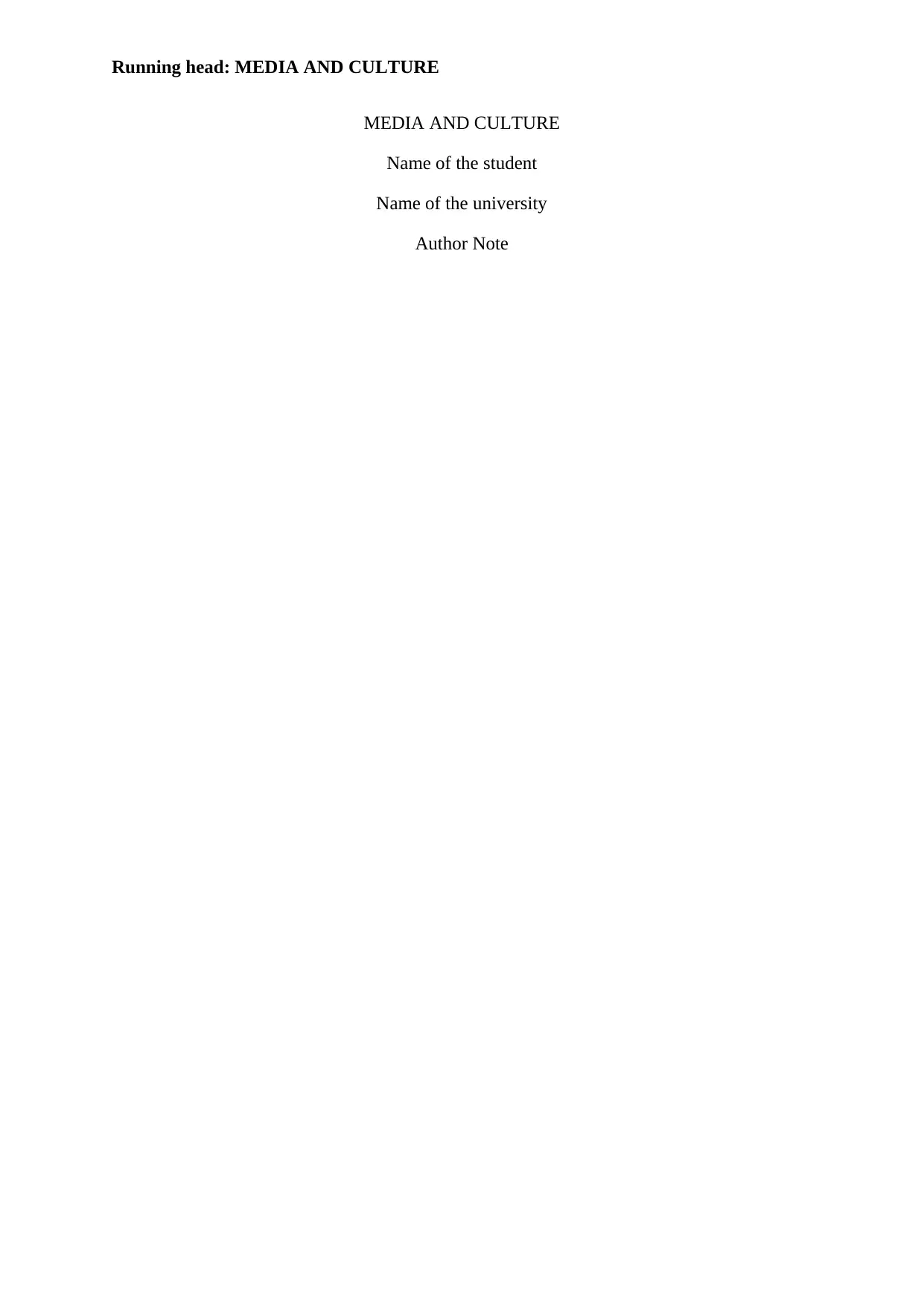
Running head: MEDIA AND CULTURE
MEDIA AND CULTURE
Name of the student
Name of the university
Author Note
MEDIA AND CULTURE
Name of the student
Name of the university
Author Note
Secure Best Marks with AI Grader
Need help grading? Try our AI Grader for instant feedback on your assignments.
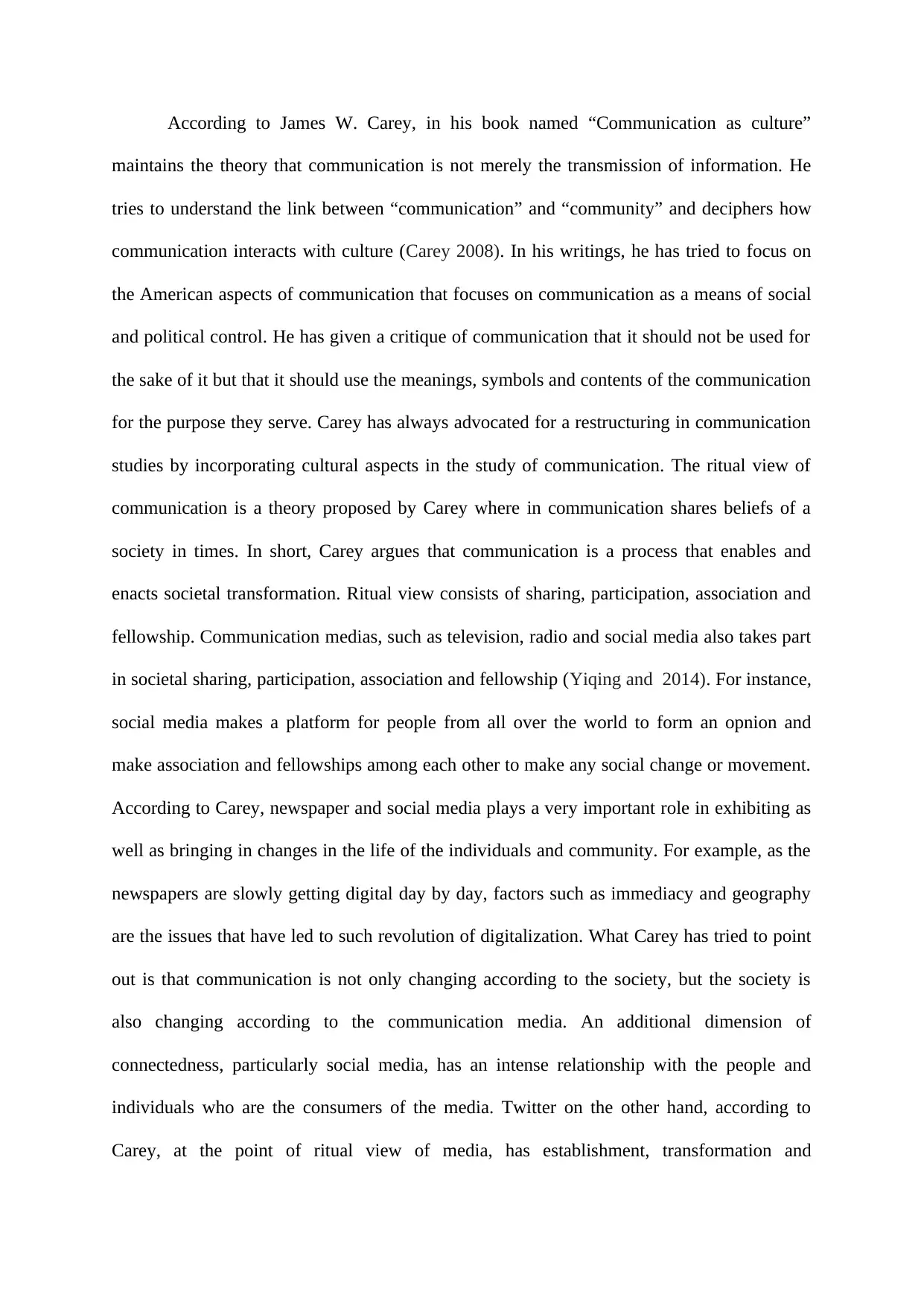
According to James W. Carey, in his book named “Communication as culture”
maintains the theory that communication is not merely the transmission of information. He
tries to understand the link between “communication” and “community” and deciphers how
communication interacts with culture (Carey 2008). In his writings, he has tried to focus on
the American aspects of communication that focuses on communication as a means of social
and political control. He has given a critique of communication that it should not be used for
the sake of it but that it should use the meanings, symbols and contents of the communication
for the purpose they serve. Carey has always advocated for a restructuring in communication
studies by incorporating cultural aspects in the study of communication. The ritual view of
communication is a theory proposed by Carey where in communication shares beliefs of a
society in times. In short, Carey argues that communication is a process that enables and
enacts societal transformation. Ritual view consists of sharing, participation, association and
fellowship. Communication medias, such as television, radio and social media also takes part
in societal sharing, participation, association and fellowship (Yiqing and 2014). For instance,
social media makes a platform for people from all over the world to form an opnion and
make association and fellowships among each other to make any social change or movement.
According to Carey, newspaper and social media plays a very important role in exhibiting as
well as bringing in changes in the life of the individuals and community. For example, as the
newspapers are slowly getting digital day by day, factors such as immediacy and geography
are the issues that have led to such revolution of digitalization. What Carey has tried to point
out is that communication is not only changing according to the society, but the society is
also changing according to the communication media. An additional dimension of
connectedness, particularly social media, has an intense relationship with the people and
individuals who are the consumers of the media. Twitter on the other hand, according to
Carey, at the point of ritual view of media, has establishment, transformation and
maintains the theory that communication is not merely the transmission of information. He
tries to understand the link between “communication” and “community” and deciphers how
communication interacts with culture (Carey 2008). In his writings, he has tried to focus on
the American aspects of communication that focuses on communication as a means of social
and political control. He has given a critique of communication that it should not be used for
the sake of it but that it should use the meanings, symbols and contents of the communication
for the purpose they serve. Carey has always advocated for a restructuring in communication
studies by incorporating cultural aspects in the study of communication. The ritual view of
communication is a theory proposed by Carey where in communication shares beliefs of a
society in times. In short, Carey argues that communication is a process that enables and
enacts societal transformation. Ritual view consists of sharing, participation, association and
fellowship. Communication medias, such as television, radio and social media also takes part
in societal sharing, participation, association and fellowship (Yiqing and 2014). For instance,
social media makes a platform for people from all over the world to form an opnion and
make association and fellowships among each other to make any social change or movement.
According to Carey, newspaper and social media plays a very important role in exhibiting as
well as bringing in changes in the life of the individuals and community. For example, as the
newspapers are slowly getting digital day by day, factors such as immediacy and geography
are the issues that have led to such revolution of digitalization. What Carey has tried to point
out is that communication is not only changing according to the society, but the society is
also changing according to the communication media. An additional dimension of
connectedness, particularly social media, has an intense relationship with the people and
individuals who are the consumers of the media. Twitter on the other hand, according to
Carey, at the point of ritual view of media, has establishment, transformation and
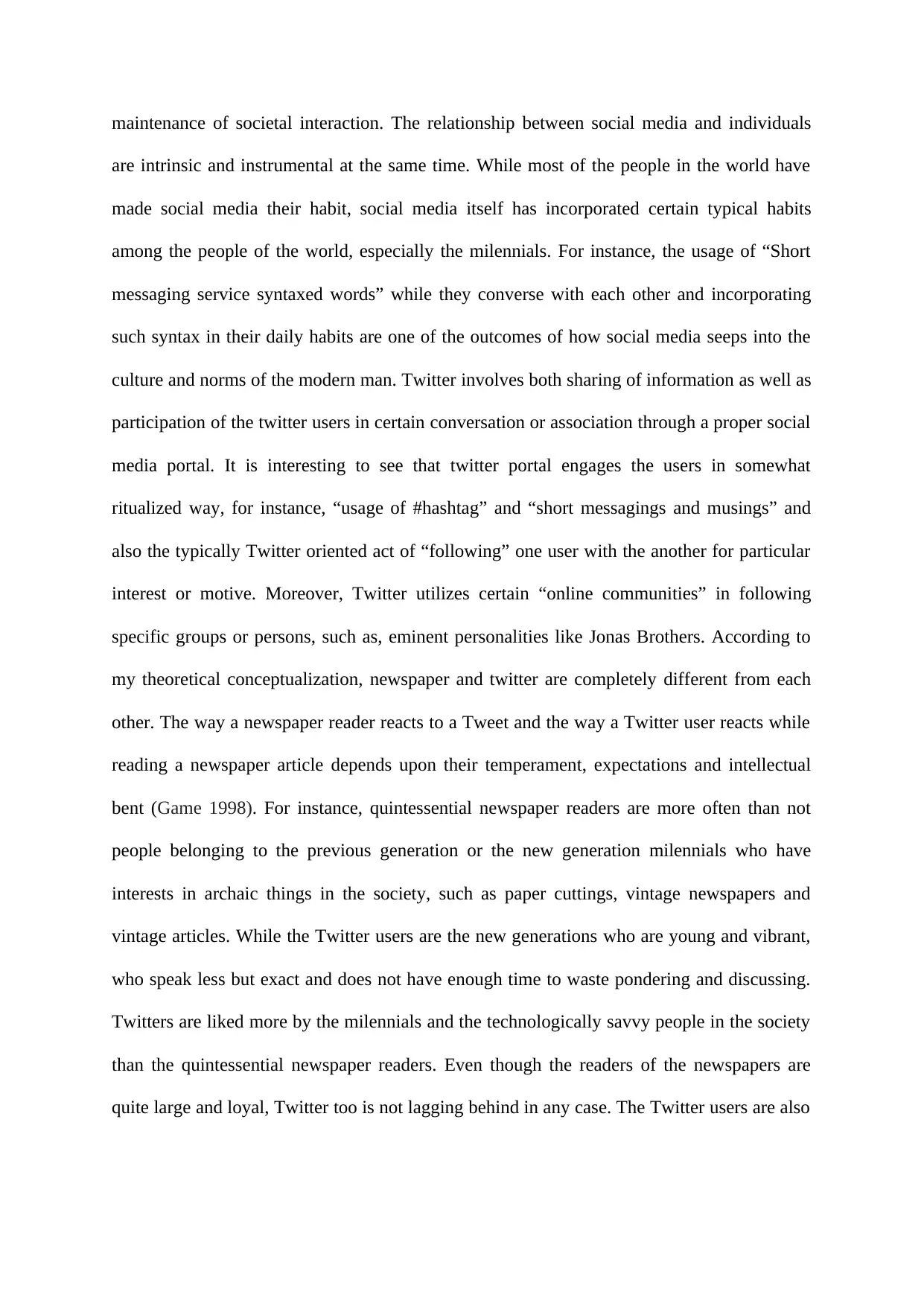
maintenance of societal interaction. The relationship between social media and individuals
are intrinsic and instrumental at the same time. While most of the people in the world have
made social media their habit, social media itself has incorporated certain typical habits
among the people of the world, especially the milennials. For instance, the usage of “Short
messaging service syntaxed words” while they converse with each other and incorporating
such syntax in their daily habits are one of the outcomes of how social media seeps into the
culture and norms of the modern man. Twitter involves both sharing of information as well as
participation of the twitter users in certain conversation or association through a proper social
media portal. It is interesting to see that twitter portal engages the users in somewhat
ritualized way, for instance, “usage of #hashtag” and “short messagings and musings” and
also the typically Twitter oriented act of “following” one user with the another for particular
interest or motive. Moreover, Twitter utilizes certain “online communities” in following
specific groups or persons, such as, eminent personalities like Jonas Brothers. According to
my theoretical conceptualization, newspaper and twitter are completely different from each
other. The way a newspaper reader reacts to a Tweet and the way a Twitter user reacts while
reading a newspaper article depends upon their temperament, expectations and intellectual
bent (Game 1998). For instance, quintessential newspaper readers are more often than not
people belonging to the previous generation or the new generation milennials who have
interests in archaic things in the society, such as paper cuttings, vintage newspapers and
vintage articles. While the Twitter users are the new generations who are young and vibrant,
who speak less but exact and does not have enough time to waste pondering and discussing.
Twitters are liked more by the milennials and the technologically savvy people in the society
than the quintessential newspaper readers. Even though the readers of the newspapers are
quite large and loyal, Twitter too is not lagging behind in any case. The Twitter users are also
are intrinsic and instrumental at the same time. While most of the people in the world have
made social media their habit, social media itself has incorporated certain typical habits
among the people of the world, especially the milennials. For instance, the usage of “Short
messaging service syntaxed words” while they converse with each other and incorporating
such syntax in their daily habits are one of the outcomes of how social media seeps into the
culture and norms of the modern man. Twitter involves both sharing of information as well as
participation of the twitter users in certain conversation or association through a proper social
media portal. It is interesting to see that twitter portal engages the users in somewhat
ritualized way, for instance, “usage of #hashtag” and “short messagings and musings” and
also the typically Twitter oriented act of “following” one user with the another for particular
interest or motive. Moreover, Twitter utilizes certain “online communities” in following
specific groups or persons, such as, eminent personalities like Jonas Brothers. According to
my theoretical conceptualization, newspaper and twitter are completely different from each
other. The way a newspaper reader reacts to a Tweet and the way a Twitter user reacts while
reading a newspaper article depends upon their temperament, expectations and intellectual
bent (Game 1998). For instance, quintessential newspaper readers are more often than not
people belonging to the previous generation or the new generation milennials who have
interests in archaic things in the society, such as paper cuttings, vintage newspapers and
vintage articles. While the Twitter users are the new generations who are young and vibrant,
who speak less but exact and does not have enough time to waste pondering and discussing.
Twitters are liked more by the milennials and the technologically savvy people in the society
than the quintessential newspaper readers. Even though the readers of the newspapers are
quite large and loyal, Twitter too is not lagging behind in any case. The Twitter users are also
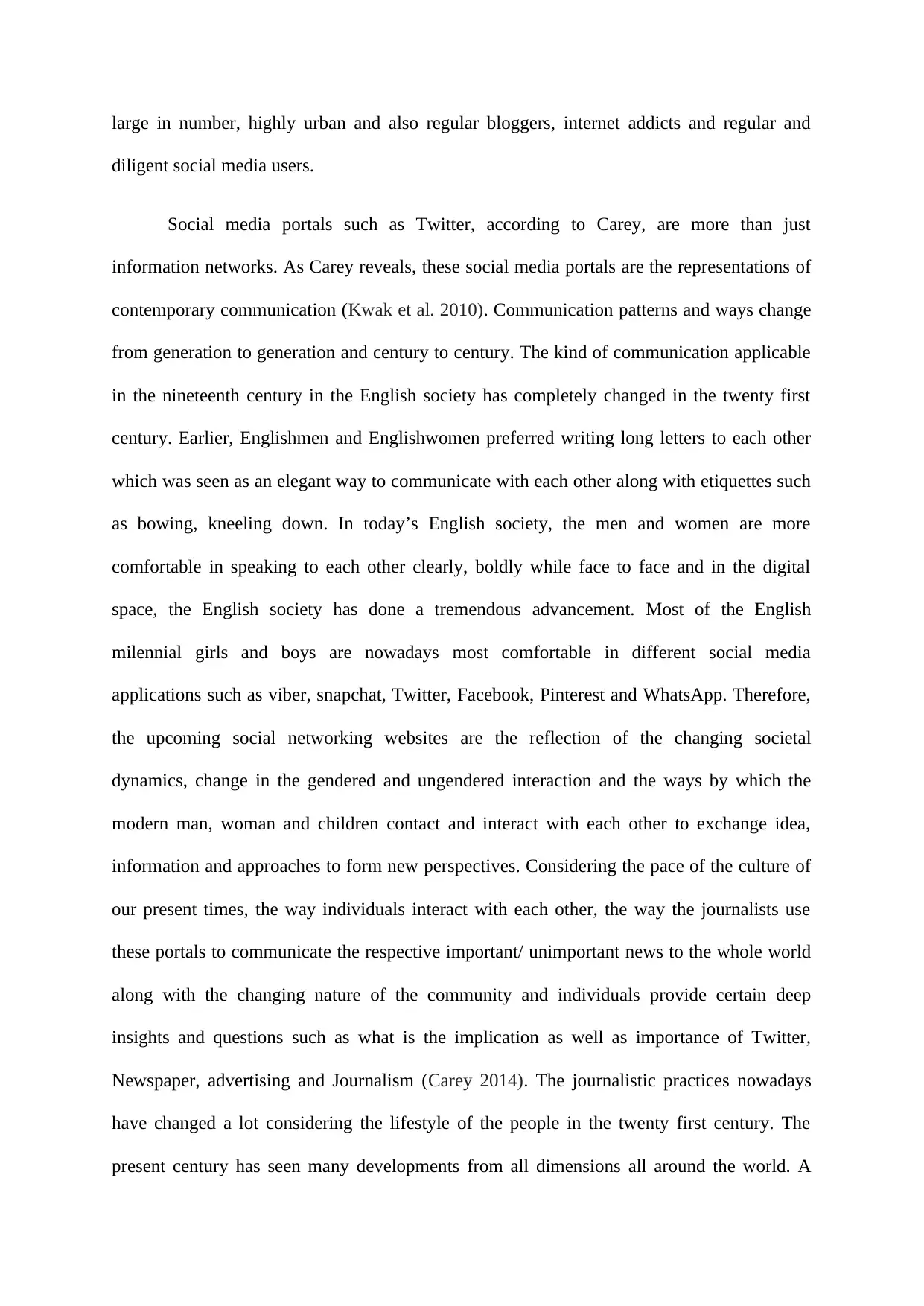
large in number, highly urban and also regular bloggers, internet addicts and regular and
diligent social media users.
Social media portals such as Twitter, according to Carey, are more than just
information networks. As Carey reveals, these social media portals are the representations of
contemporary communication (Kwak et al. 2010). Communication patterns and ways change
from generation to generation and century to century. The kind of communication applicable
in the nineteenth century in the English society has completely changed in the twenty first
century. Earlier, Englishmen and Englishwomen preferred writing long letters to each other
which was seen as an elegant way to communicate with each other along with etiquettes such
as bowing, kneeling down. In today’s English society, the men and women are more
comfortable in speaking to each other clearly, boldly while face to face and in the digital
space, the English society has done a tremendous advancement. Most of the English
milennial girls and boys are nowadays most comfortable in different social media
applications such as viber, snapchat, Twitter, Facebook, Pinterest and WhatsApp. Therefore,
the upcoming social networking websites are the reflection of the changing societal
dynamics, change in the gendered and ungendered interaction and the ways by which the
modern man, woman and children contact and interact with each other to exchange idea,
information and approaches to form new perspectives. Considering the pace of the culture of
our present times, the way individuals interact with each other, the way the journalists use
these portals to communicate the respective important/ unimportant news to the whole world
along with the changing nature of the community and individuals provide certain deep
insights and questions such as what is the implication as well as importance of Twitter,
Newspaper, advertising and Journalism (Carey 2014). The journalistic practices nowadays
have changed a lot considering the lifestyle of the people in the twenty first century. The
present century has seen many developments from all dimensions all around the world. A
diligent social media users.
Social media portals such as Twitter, according to Carey, are more than just
information networks. As Carey reveals, these social media portals are the representations of
contemporary communication (Kwak et al. 2010). Communication patterns and ways change
from generation to generation and century to century. The kind of communication applicable
in the nineteenth century in the English society has completely changed in the twenty first
century. Earlier, Englishmen and Englishwomen preferred writing long letters to each other
which was seen as an elegant way to communicate with each other along with etiquettes such
as bowing, kneeling down. In today’s English society, the men and women are more
comfortable in speaking to each other clearly, boldly while face to face and in the digital
space, the English society has done a tremendous advancement. Most of the English
milennial girls and boys are nowadays most comfortable in different social media
applications such as viber, snapchat, Twitter, Facebook, Pinterest and WhatsApp. Therefore,
the upcoming social networking websites are the reflection of the changing societal
dynamics, change in the gendered and ungendered interaction and the ways by which the
modern man, woman and children contact and interact with each other to exchange idea,
information and approaches to form new perspectives. Considering the pace of the culture of
our present times, the way individuals interact with each other, the way the journalists use
these portals to communicate the respective important/ unimportant news to the whole world
along with the changing nature of the community and individuals provide certain deep
insights and questions such as what is the implication as well as importance of Twitter,
Newspaper, advertising and Journalism (Carey 2014). The journalistic practices nowadays
have changed a lot considering the lifestyle of the people in the twenty first century. The
present century has seen many developments from all dimensions all around the world. A
Secure Best Marks with AI Grader
Need help grading? Try our AI Grader for instant feedback on your assignments.
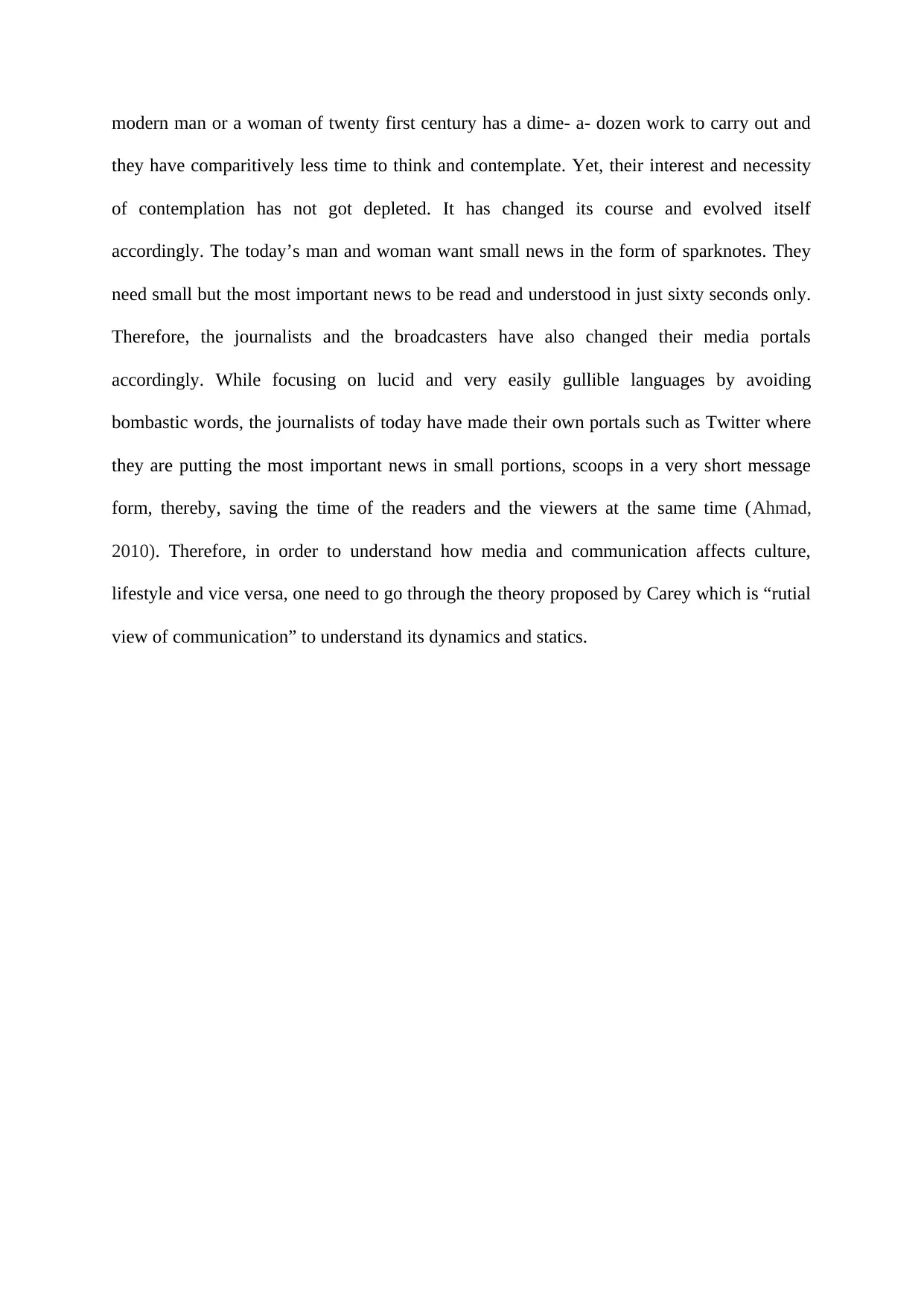
modern man or a woman of twenty first century has a dime- a- dozen work to carry out and
they have comparitively less time to think and contemplate. Yet, their interest and necessity
of contemplation has not got depleted. It has changed its course and evolved itself
accordingly. The today’s man and woman want small news in the form of sparknotes. They
need small but the most important news to be read and understood in just sixty seconds only.
Therefore, the journalists and the broadcasters have also changed their media portals
accordingly. While focusing on lucid and very easily gullible languages by avoiding
bombastic words, the journalists of today have made their own portals such as Twitter where
they are putting the most important news in small portions, scoops in a very short message
form, thereby, saving the time of the readers and the viewers at the same time (Ahmad,
2010). Therefore, in order to understand how media and communication affects culture,
lifestyle and vice versa, one need to go through the theory proposed by Carey which is “rutial
view of communication” to understand its dynamics and statics.
they have comparitively less time to think and contemplate. Yet, their interest and necessity
of contemplation has not got depleted. It has changed its course and evolved itself
accordingly. The today’s man and woman want small news in the form of sparknotes. They
need small but the most important news to be read and understood in just sixty seconds only.
Therefore, the journalists and the broadcasters have also changed their media portals
accordingly. While focusing on lucid and very easily gullible languages by avoiding
bombastic words, the journalists of today have made their own portals such as Twitter where
they are putting the most important news in small portions, scoops in a very short message
form, thereby, saving the time of the readers and the viewers at the same time (Ahmad,
2010). Therefore, in order to understand how media and communication affects culture,
lifestyle and vice versa, one need to go through the theory proposed by Carey which is “rutial
view of communication” to understand its dynamics and statics.

References:
Ahmad, A.N., 2010. Is Twitter a useful tool for journalists?. Journal of media practice, 11(2),
pp.145-155.
Carey, J.W., 2008. Communication as culture, revised edition: Essays on media and society.
Routledge.
Carey, J.W., 2014. Advertising: An institutional approach. In Readings in Advertising,
Society, and Consumer Culture (pp. 39-49). Routledge.
Game, J.A., 1998. Communication, culture, and technology: An Internet interview with
James W. Carey.
Kwak, H., Lee, C., Park, H. and Moon, S., 2010, April. What is Twitter, a social network or a
news media?. In Proceedings of the 19th international conference on World wide web (pp.
591-600).
Yiqing, H. and Yue, W., 2014. Carey's" Ritual View of Communication": A Dilemma of the
American Cultural Studies' Localization [J]. Journalism & Communication, 6.
Ahmad, A.N., 2010. Is Twitter a useful tool for journalists?. Journal of media practice, 11(2),
pp.145-155.
Carey, J.W., 2008. Communication as culture, revised edition: Essays on media and society.
Routledge.
Carey, J.W., 2014. Advertising: An institutional approach. In Readings in Advertising,
Society, and Consumer Culture (pp. 39-49). Routledge.
Game, J.A., 1998. Communication, culture, and technology: An Internet interview with
James W. Carey.
Kwak, H., Lee, C., Park, H. and Moon, S., 2010, April. What is Twitter, a social network or a
news media?. In Proceedings of the 19th international conference on World wide web (pp.
591-600).
Yiqing, H. and Yue, W., 2014. Carey's" Ritual View of Communication": A Dilemma of the
American Cultural Studies' Localization [J]. Journalism & Communication, 6.
1 out of 6
Your All-in-One AI-Powered Toolkit for Academic Success.
+13062052269
info@desklib.com
Available 24*7 on WhatsApp / Email
![[object Object]](/_next/static/media/star-bottom.7253800d.svg)
Unlock your academic potential
© 2024 | Zucol Services PVT LTD | All rights reserved.

